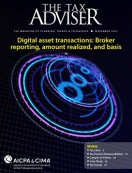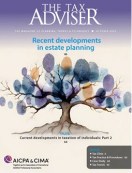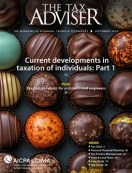- newsletter
- TAX INSIDER

Avoiding a transfer-pricing audit: 3 best practices for multinationals
The right approach can help avoid unwanted attention from the IRS and other regulators.
Please note: This item is from our archives and was published in 2018. It is provided for historical reference. The content may be out of date and links may no longer function.
Related
IRS announces prop. regs. on international tax law provisions in OBBBA
QSBS gets a makeover: What tax pros need to know about Sec. 1202’s new look
IRS ruling clarifies treatment of R&D when computing the FDII deduction
Transfer pricing has gained more attention in recent years as more and more organizations conduct business internationally. With this increased activity, the IRS and other authorities around the globe have identified transfer pricing as an underused source of tax revenue. In truth, effectively navigating transfer-pricing regulations may be less about avoiding taxes and more about making smart decisions in growing and scaling international businesses, including complying fully with fiscal requirements in the various jurisdictions in which the businesses operate.
In broad strokes, transfer pricing is focused on how departments, companies, and enterprises under common ownership handle transactions of services, goods, or intangible items within the United States and across national borders. Companies could gain a market and tax advantage by manipulating the prices they charge to move goods and services between entities under shared ownership. Regulations prevent this advantage by requiring that related entities use arm’s-length pricing — meaning they charge and pay prices similar to what unconnected organizations negotiating at arm’s length would pay. In this way, related entities are put on an equal tax footing with independent entities.
IRS guidance offers an inside look at transfer-pricing exams
The IRS recently offered a peek behind the curtain into how the agency decides where to focus scrutiny of transfer pricing by multinational corporations. In June 2018, the IRS issued new guidelines in Publication 5300,Transfer Pricing Examination Process (August 2018). The new guidance document replaces the agency’s Transfer Pricing Audit Roadmap, released in 2014.
This guide, written by the Treaty and Transfer Pricing Operations Practice Area of the Large Business and International Division of the IRS as a resource for IRS examiners and auditors, offers rules and best practices in planning, executing, and resolving transfer-pricing examinations. The document is also shared with companies at the start of any examination. But organizations can benefit from this inside look at the IRS’s processes and priorities long before an examiner shows up at their door. With these updated guidelines in mind, here are three key insights that can be applied to transfer-pricing protocols and prevent an audit from happening at all.
1. Be as specific and consistent as possible
In evaluating multinational firms and gauging potential audit targets, the IRS will focus on details. It’s best to maintain thorough, accurate accounts of intercompany transactions rather than rely on generic information. The more detailed information businesses can provide the IRS on company agreements and invoices, the more likely the IRS will be to shift its attention elsewhere.
These details must also be consistent among all transactions. Organizations have multiple methods to determine arm’s-length pricing. Once a method is chosen, it must be used by the entire organization across all departments. This consistency must follow through to product pricing as well.
Ultimately, IRS officials are looking for a narrative that runs through transfer-pricing protocols. They want to see the rationale and reasoning behind transfer-pricing practices with specific details and consistent arm’s-length pricing determinations throughout the organization.
2. Ensure ongoing compliance
As recent IRS updates demonstrate, regulatory priorities and specific directives can shift over time. Multinational corporations must stay on top of these changes to ensure they’re not attracting unwanted IRS attention. And U.S. regulations are only part of the equation — more than 75 countries have transfer-pricing regulations. Organizations must be current on regulatory nuances in every country where they operate and conduct transactions.
For many firms, commissioning or conducting a transfer-pricing study is a critical first step, but it is only the first step. The study needs to be analyzed, implemented, and maintained. In some cases, failing to effectively implement policies based on the results of the study can actually expose multinational companies to increased regulatory scrutiny.
Often, using an external team can create consistency and accountability in complying with transfer-pricing rules. Companies should look for an outside team that can coordinate preparation of policies and documentation across multinational enterprise groups. Maintaining a centralized and consistent approach is an effective way to tell the same story across a global organization, which has never been more important.
3. Don’t raise red flags
Even with the right protocols in place, it pays to make sure your organization isn’t raising additional red flags that attract regulatory scrutiny. Tax return preparation should include robust details about transfer-pricing practices and explain any activities likely to lead to IRS questions. These include significant intercompany transactions, retrospective adjustments, and transactions with low-tax jurisdictions.
In some cases, negotiating an advance pricing agreement is the best way for a multinational organization to ensure effective compliance. For companies making considerable changes to transfer-pricing practices, including expanding into new regions or updating arm’s-length determinations, this upfront agreement with the IRS and other tax authorities can create a more predictable and transparent tax process. Here again, a trusted external adviser is often a valuable partner in negotiating this agreement and making sure intercompany transactions don’t raise additional red flags.
Avoiding an audit
With these broad guidelines in place, a closer read of the updated IRS guidelines with internal or external transfer-pricing experts can help guide a more specific plan of action. The right approach and consistent vigilance can help multinational organizations to avoid unwanted attention from the IRS and other regulators.
David Slemmer is a principal at PKF O’Connor Davies with over 20 years of professional experience. He has performed transfer-pricing evaluation and planning projects for large multinational companies as well as for midmarket businesses across all industries, particularly life sciences, consumer business, and manufacturing. To comment about this article or to suggest an idea for another article, please contact Sally Schreiber, senior editor, at Sally.Schreiber@aicpa-cima.com.














